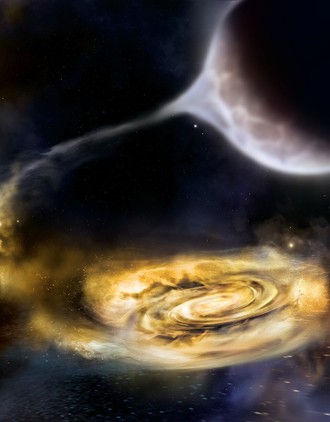
The fall of matter, called "accretion", onto black holes can generate tremendous amounts of energy. In close binary systems, the matter sucked in from the stellar companion by the gravitational pull of the black hole forms a flat rotating structure called an "accretion disc”, in which matter travels on circular orbits. From time to time accretion discs around black holes undergo outbursts, becoming the brightest X-ray sources in the sky. In order to get close to a black hole, matter must reduce its amount of rotation, measured by its angular momentum.
Accretion is driven by an angular-momentum removal mechanism. Traditionally, the efficiency of this mechanism is encapsulated in a parameter called alpha. Already in 1999, Józef Smak from the Nicolaus Copernicus Astronomical
Center (NCAC) in Warsaw determined the value of alpha in outbursting discs around white dwarfs in dwarf nova stars. The value of 0.2 he found was later confirmed by Iwona Kotko (NCAC) and Jean-Pierre Lasota who, in collaboration with colleagues from the University of California in Santa Barbara, showed that that it corresponds to the predictions of the magneto-rotational instability (MRI) mechanism believed to drive accretion in disc. However, alpha has never before been measured in discs around black holes and it was assumed that it is the same as in dwarf novae.
Based on a population study of Galactic black-hole X-ray binaries through their outburst activity, Bailey Tetarenko, Craig Heinke, and Gregory Sivakoff developed a comprehensive set of data called WATCHDOG, (Whole-sky A-lberta Time-resolved Comprehensive black-Hole Database Of the Galaxy). Using 20 years of data from five satellites of three international space agencies, they used advanced statistical techniques to study 21 X-ray outbursts from 12 stellar-mass black hole X-ray binary systems and compared their light-curves with a theoretical model developed by Guillaume Dubus and Jean-Pierre Lasota. This study showed unambiguously that in accretion discs around black holes the value of the alpha parameter is contained between 0.2 and 1, higher than what has been measured in dwarf novae. The standard MRI cannot produce such values, which shows that an additional accretion driving mechanism is operating in these systems. It has been shown that such a mechanism must involve strong winds being blown out from the disc.
This provides the first evidence for the existence of strong winds surrounding black holes throughout outburst events and indicates that these winds are responsible for blowing some matter out of the black hole’s accretion flow. Until now, strong winds had only been seen in limited parts of these events. What causes these winds has still to be explained.
“Strong disk winds traced throughout outbursts in black-hole X-ray binaries” will be published in Nature: electronic version on the 22 of January 2018 and on the 1st of February in the print issue of the journal. (doi: 10.1038/nature25159)
This work was completed by Bailey Tetarenko, Craig Heinke, and Gregory Sivakoff at the University of Alberta, Jean-Pierre Lasota at the Institut d’Astrophysique de Paris and Nicolaus Copernicus Astronomical Centre of the Polish Academy of Sciences in Warsaw, and Guillaume Dubus at the Institut de Planétologie et d’Astrophysique de Grenoble. Data used were collected from five international X-ray observatories: NASA’s Rossi X-ray Timing Explorer, Neil Gehrels Swift Observatory, and Chandra X-Observatory; the Japan Aerospace Exploration Agency’s Monitor of All-sky Image Telescope on the International Space Station; and the European Space Agency's X-ray Multi-Mirror Mission (XMM-Newton). Support for this work was provided by the Natural Sciences and Engineering Research Council of Canada, National Science Foundation, the Polish National Science Centre through an OPUS Grant, and the French Space Agency CNES.
Illustration: Artistic rendition of strong winds disrupting the outer disc of material surrounding a stellar-mass black hole. The disk material (mostly in yellow) is first pulled from the outer parts of a nearby star (upper right-hand). The stellar-mass black hole sits at the center of the approximately 5 million kilometer disc, but it only consumes the material if and when it reaches the central 30 kilometers. (Source: NASA/Swift/A. Simmonet , Sonoma State University.)






